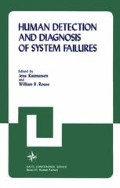Abstract
After reviewing 31 different descriptions of maintainability, Rigby and his associates developed the following definition:
“Maintainability is a quality of the combined features and characteristics of equipment design, job aids, and job supports which facilitate the rapidity, economy, ease, and accuracy with which maintenance operations can be performed, and the system thus kept in or returned to operating condition, by average ... personnel, under the environmental conditions in which the system will be maintained.” (Rigby, et al, 1961, as quoted in Crawford and Altman, 1972).
Access this chapter
Tax calculation will be finalised at checkout
Purchases are for personal use only
Preview
Unable to display preview. Download preview PDF.
References
Anon, “One Way to Minimize NC Downtime”, Iron Age, 222, May, 1979.
Blandow, R.W., “A Maintenance Overview of CAM Technology”, Manufacturing Engineering, July 1979.
Christensen, J.M., “Human Factors Considerations in Design for Reliability and Maintainability”, In Pew, R.W., “Human Factors Engineering”, Course No. 7936, Engineering Summer conferences, The University of Michigan, 1979.
Crawford, B.M. and Altman, J.W., “Designing for Maintainability” in VanCott, H.P. and Kinkade, R.G. (eds.), Human Engineering Guide to Equipment Design, Washington, D.C.: U.S. Government Printing Office, 1972.
Feineman, G., “How To Live with Reliability Engineers”, Spectrum, Spring, 1978.
Geise, J. and Haller, W.W. (eds.), Maintainability Engineering, Martin-Marietta Corporation and Duke University, 1965.
Goldstein, D.B. and Rosenfeld, A.T., Energy Conservation in Home Applicances Through Comparison Shopping: Facts and Fact Sheets, LBL-5236, Energy Extension Services, State of California, 1977.
King, J.B. (Chm.), Safety Recommendations A-79–98 through 105, National Transportation Safety Board, Washington, D.C., December 21, 1979.
Kirkman, J., “Controlled English Avoids Multi-Translations”, Industrial Engineering, February, 1978.
Leuba, H.R., “Maintainability Prediction — The Next Generation”, Proceedings of the Spring Session or Reliability, Maintainability, etc., HIE, Boston, 1967.
Liston, L.L. and Aiken, C.A., Cost of Owning and Operating an Automobile,’ U.S. Department of Transportation, Federal Highway Administration, Washington, D.C., 1977.
Ostwald, P.F. and O’Toole, P.I., “I.E.’s and Cost Estimating”, Industrial Engineering, February, 1978.
Post, C.T., “Microprocessor Control Diagnoses Welder Faults”, Iron Age, 222, 41, November 1979.
Rigby, L.V., Cooper, J.I. and Spickard, W.P., Guide to Integrated System Design for Maintainability, ASD Tech. Report 61–424, WPAFB, Ohio, October, 1961.
Rigby, L.V., The Saudia Human Error Rate Bank (SHERB). SC-R-67--1150, Saudia Labs. Albuquerque, New Mexico, 1967.
Rouse, W.B., “Human Problem Solving Performance in a Fault Diagnosis Task”, IEEE Transactions on Systems, Man, and Cybernetics, Vol. SMC-8, No. 4, 1978.
Rouse, W.B., “A Model of Human Decision Making in a Fault Diagnosis Task”, IEEE Transactions on Systems, Man and Cybernetics, Vol. SMC-8, No. 5, 1978.
Rouse, W.B., “A Model of Human Decision Making in Fault Diagnosis Tasks That Include Feedback and Redundancy”, IEEE Transactions on Systems, Man and Cybernetics, Vol. SMC-9, No. 4, 1979.
Rouse, W.B., “Problem Solving Performance of Maintenance Trainees in a Fault Diagnosis Task”, Human Factors, Vol. 21, No. 2, 1979.
Rouse, W.B., “Problem Solving Performance of First Semester Maintenance Trainees in Two Fault Diagnosis Tasks”, Human Factors, Vol. 21, No. 4, 1979.
Sauer, D., Campbell, W.B., Potter, N.R. and Askren, W.B., Relationships Between Human Resource Factors and Performance on Nuclear Missile Handling Tasks. AFHRL-TR-76–85/AFWL-TR-76--301, Air Force Human Resources Laboratory/Air Force Weapons Laboratory, 1976.
Stranhagen, J.F. Jr., How good are Maintenance Data? Spectrum, Spring, 1978.
Author information
Authors and Affiliations
Editor information
Editors and Affiliations
Rights and permissions
Copyright information
© 1981 Plenum Press, New York
About this chapter
Cite this chapter
Christensen, J.M., Howard, J.M. (1981). Field Experience in Maintenance. In: Rasmussen, J., Rouse, W.B. (eds) Human Detection and Diagnosis of System Failures. NATO Conference Series, vol 15. Springer, Boston, MA. https://doi.org/10.1007/978-1-4615-9230-3_8
Download citation
DOI: https://doi.org/10.1007/978-1-4615-9230-3_8
Publisher Name: Springer, Boston, MA
Print ISBN: 978-1-4615-9232-7
Online ISBN: 978-1-4615-9230-3
eBook Packages: Springer Book Archive

